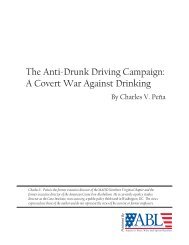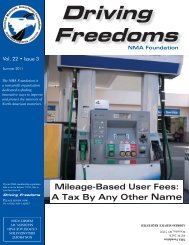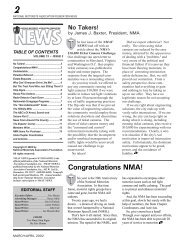Driving Freedoms - National Motorists Association
Driving Freedoms - National Motorists Association
Driving Freedoms - National Motorists Association
You also want an ePaper? Increase the reach of your titles
YUMPU automatically turns print PDFs into web optimized ePapers that Google loves.
<strong>Driving</strong> <strong>Freedoms</strong>Spring 2011Vehicle Accident Reconstruction − An Overview, Part 2by Jerry F. Cuderman II, Ph.D., P.E.Part 1 of Dr. Cuderman’s articleappeared in the Winter 2011 issue of<strong>Driving</strong> <strong>Freedoms</strong>.If an accident reconstructionistis hired soon enough after the actualevent, much of the physical evidenceleft by the collision may still beat the site. However, even if thephysical evidence is largely gone,there are techniquesto reacquire the dataif police investigatorsor others take sufficientphotographsshortly after theaccident.Proper photographictechniquesare time-consumingand involve usingspecial camerasand/or computersoftware, but areessential in reconstructingthe collisionin the absense of keyphysical evidence.There are a number of factorsthat are often analyzed in accidentreconstruction (AR): nighttimevisibility, visual conspicuity, lampfilament analysis (to determine ifvehicle headlights were on at thetime of collision), traffic light timingand sequence, roadway frictionissues, hydroplaning, mechanicalfailure, signage, braking performance,and yaw mark (sideslip)analysis, just to name a few. Everycollision presents a different set ofanalysis requirements for AR.A more recent class of physicalevidence involves event datarecorders (EDR), often referred toas black boxes. Although the latterterm is a bit of a misnomer, more andmore vehicles are equipped with ameans of recording crash informationthat is useful in determining whathappened. At the very least, typicalrecording equipment will registerinformation regarding the crashpulse, which is the change in speedof the vehicle during the collision.Some EDRs will provide up toseveral minutes of data prior to thecollision, including vehicle speed,brake light and anti-lock brakestatus, transmission gear selectorposition, throttle position, steeringwheel angle, vehicle rotation rates,seatbelt usage, and more.It is critically important to knowhow to interpret the EDR data. Oneof the biggest effects that suchdata have had is keeping everyone“honest,” since the collected informationoften provides a solid foundationthat cannot be ignored. Hence,the “black box” does not replace ARbut can actually enhance it.On a side note, whether the lawsays the owner of the vehicle “owns”the data appears to be largely irrelevant– I have never been involvedin a case in the past 15 years whereaccess to the data was not ultimatelyagreed to by the owner or ordered bythe court.AR can ordinarily determinewhat occurred in an incident withoutthe availability of EDR data.Analysis of the physical evidencevaries from collision to collision. Itis almost always necessary to studythe physical evidence to determinehow vehicles movedprior to, during,and after impact.Estimating vehiclespeed is also importantand typicallyrequires application ofthe physics of conservationof momentumand conservation ofenergy.Sometimes datafrom the vehicle arenearly self-explanatoryrelative to speedand not much elseneeds to be analyzed.There are also occasions where it isnecessary to accurately measure howmuch a vehicle was crushed duringan accident.That information can then beused in conjunction with governmentor other crash test data to calculatethe energy of the collision itself.Through this process, a completepicture of the vehicle speeds beforeand after the collision can bedeveloped.In addition, it is often necessaryto perform a time and motionanalysis to determine, (1) the relativepositions of the vehicles through thecourse of the accident, (2) what each(Continued top of next page)






